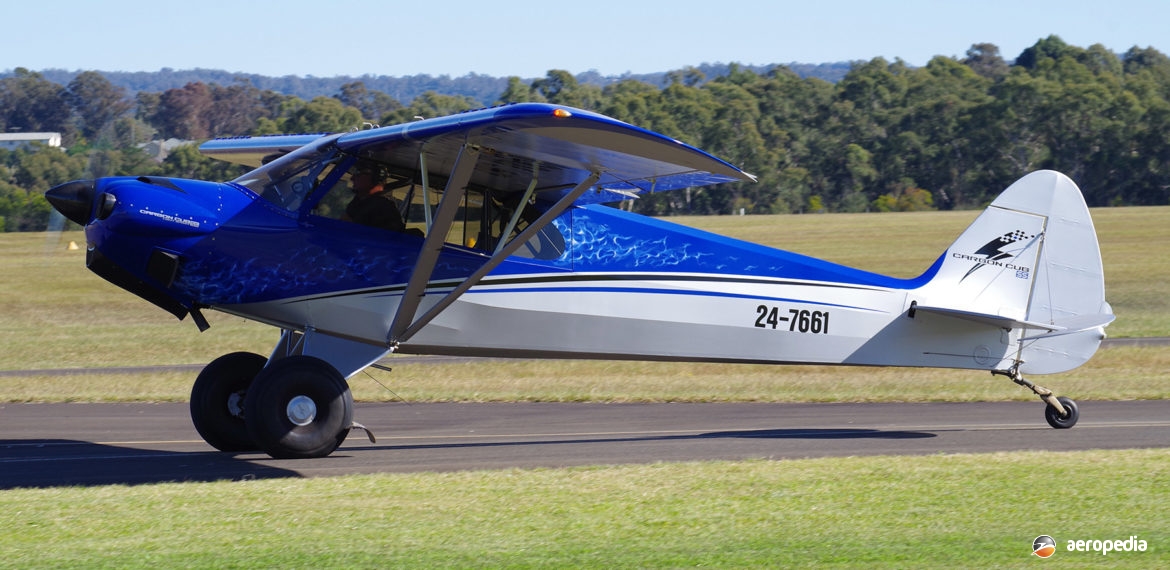Photograph:
CubCrafters Carbon Cub SS 24-7661 (c/n CC11-00148 – ex N881AW) at Camden, NSW in June 2015 (David C Eyre)
Country of origin:
United States of America
Description:
Two-seat light sport monoplane
Power Plant:
[CC11-160]
One 134 kw (180 hp) Titan 340CC four-cylinder horizontally-opposed air-cooled engine
Specifications:
- Wingspan: 10.4 m (34 ft 3 in)
- Length: 7.1 m (23 ft 3 in)
- Height: 2.56 m (8 ft 4 in)
- Wing area: 16.6 m² (179 sq ft)
- Never exceed speed: 227 km/h (141 mph)
- Cruising speed: 185 km/h (115 mph)
- Stalling speed with flaps: 51 km/h (32 mph)
- Stalling speed without flaps: 64 km/h (40 mph)
- Endurance: 4
- Max range: 724 km (450 miles)
- Rate of climb: 640 m/min (2,100 ft/min)
- Take-off roll: 18 m (60 ft)
- Landing roll: 75 m (245 ft)
- Empty weight: 406 kg (896 lb)
- Loaded weight with wheels: 599 kg (1,320 lb)
- Loaded weight with floats: 649 kg (1,430 lb)
History:
As noted in the Top Cub article, CubCrafters was founded in 1980 by James Richmond in Wisconsin to re-build and modify Piper PA-18 Super Cubs and similar aircraft, eventually re-designing the aircraft and upgrading it to meet customer requirements. The Company placed its Carbon Cub proof-of-concept aircraft before the aviation fraternity in 2007 at the Alaska State Aviation Trade Show and Conference, stating the new aircraft with a 164 kw (220 hp) engine had a number of new design features, including airframe construction materials, performance options, design improvements and engine options. Some 40 airframe parts had been made from high-strength carbon fibre, thus saving 113 kg to 136 kg (250 lb to 300 lb) of weight as compared to the original Super Cub.
The Company announced it proposed to produce an Light Sport Aircraft (LSA) certificated aircraft factory-built, and a home-built aircraft in kit form. Power plant for the Carbon Cub was the Titan 340 CC engine built b y ECi providing 134 kw (180 hp) driving a two-blade fixed-pitch propeller. This unit had a magnesium accessory case, a thermostatic oil cooler by-pass valve and an electronic ignition. It was certified to ASTM standards for light sport aircraft. This was a modernised version of a Lycoming engine design and had a 2,400 hour Time Between Overhauls (TBO).
The Carbon Cub featured a strut-braced high-wing with two seats in tandem and a fixed tailwheel undercarriage. It could be obtained in the United States as the Carbon Cub EX, this being similar to the SS but adapted to meet US experimental amateur-built regulations. The airframe was constructed from welded steel tube with aluminium and carbon fibre.
In late 2017 CubCrafters introduced two new models of the series, these being the Carbon Cub EX-3 and the FX-3, the former being a kit model and the latter a factory builder-assist model, the two aircraft essentially being the Carbon Cub airframe strengthened for a higher 907 kg (2,000 lb) gross weight and being fitted with a 139 kw (186 hp) Superior Air Parts CC363i engine driving a Hartzell constant-speed propeller.
A number of examples have been imported to this region, the Australian distributor being Cub Aircraft Australia Pty Ltd. Two became 24-7661 (c/n CC11-0048 – ex N881AW) registered on 22 October 2010 and 24-7662 (c/n CC11-00149 – ex N887RJ) also registered on 22 October 2010 under Recreational Aviation Australia (RAA) Regulations. Another became VH-YXM (c/n CC11-00271) in November 2019.

